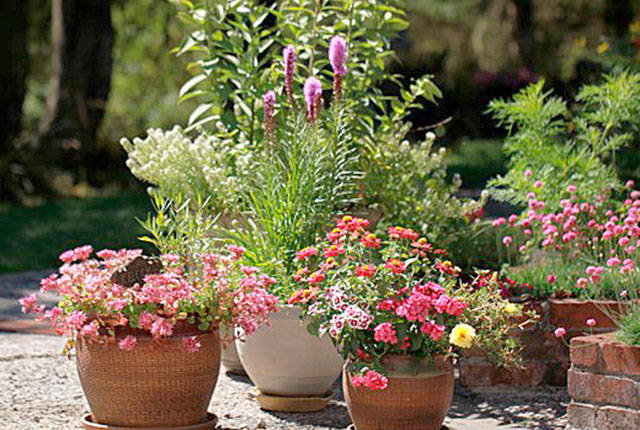July is usually warm and dry and therefore a poor month for planting. Soils dry out quickly and proper watering is critical. Water in early morning or late afternoon to minimize water loss from evaporation.
If plants are wilted, water immediately. Water slowly and long enough to soak root zones. On hot days, hanging baskets and containers need watering one to two times daily.
Hanging baskets, especially fuchsia baskets, benefit from additional weekly watering from the bottom (sit in a tray of water).
All new plantings need to be watered two to three times a week, even if they are “drought tolerant.” Apply two to three inches of mulch to garden beds to hold in moisture and discourage weeds.
Flowers: Deadhead faded flowers to extend flowering. Cut back straggly annuals to improve their appearance and stimulate a second bloom.
Stake tall plants such as lilies, dahlias, delphiniums and sunflowers early in their growth. After lilies have bloomed, cut the stalk to just below the lowest flower; the remaining stem and leaves produce energy for next year’s flowers.
Harvest lavender just as the buds show color, but before they open.
Planting: Avoid planting bare-root or ball and burlap-wrapped specimens in July. Divide and transplant crowded spring-blooming bulbs and rhizomes, including bearded iris, if flowering has declined. (See Sidebar.)
Plan for September color by planting seeds of annuals such as cosmos, calendula and zinnias.
Fertilizing: Never fertilize dry roots. Water first. Fertilize plants in containers every two weeks, as they lose nutrients from frequent watering. Fertilize dahlias monthly. Do not fertilize roses after July.
Pruning: If needed, prune spring-blooming trees and shrubs including forsythia, kerria, pieris, azalea, rhododendron, lilac and viburnum. Lightly prune vines and ground covers after bloom to thin and shorten them.
Veggies: Gather and dry herbs. Pull out finished vegetable crops, replenish the soil with compost and plant your fall/winter vegetable garden.
Sow broccoli, carrots, onions, parsley and peas by mid-July and bush beans, beets, kale and lettuce by the end of July. Set out transplants for broccoli, cabbage and cauliflower.
Watch tomatoes for late blight and immediately remove infected leaves and fruit, including those that have fallen from the plant. It may be necessary to remove the entire plant. Do not compost diseased plant parts.
Fruit trees and berries: Thin fruit on fruit trees if needed. Berry plants need at least an inch of water per week. Harvest and enjoy berry fruits as they ripen. Clean up and fertilize (10-10-10) June-bearing strawberries within a week of harvesting the last berries.
Lawns: Water deeply about once a week, or let lawn go dormant by watering once a month. Mow regularly to prevent weed seed spread. Leave clippings behind if they are not too tall or weedy. Do not fertilize the lawn during hot, dry weather.
Janet Oja and Marilyn Stewart are Washington State University-certified Clallam County Master Gardeners.


